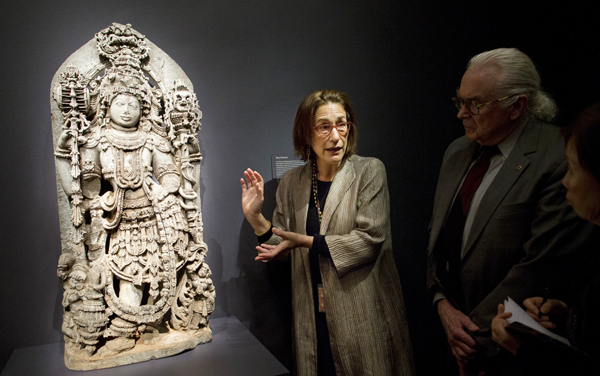Exhibit puts new twist on art, history of yoga

Debra Diamond, curator of South and Southeast Asian art, gives a tour during a press preview of “Yoga: The Art of Transformation” at the Smithsonian’s Sackler Gallery in Washington on Tuesday. [AP/NEWSIS]
The Smithsonian Institution has organized what curators believe is the first exhibition about the visual history and art of yoga, its origins and evolution over time. The Smithsonian’s Sackler Gallery will showcase the exhibit, “Yoga: The Art of Transformation,” through January.
Curators brought together Indian sculptures, manuscripts and paintings, as well as posters, illustrations, photographs and films to showcase yoga’s history over 2,000 years.
Museum Director Julian Raby said years of research behind the exhibit shed new light on yoga’s meanings and histories.
“It examines for the first time a spectacular, but until now largely ignored, archive,” he said. “That archive is India’s visual culture of extraordinary yoga-related artworks created, as you will see, over some two millennia.”
The museum also will host a symposium for scholars and enthusiasts on yoga’s visual culture.
Curator Debra Diamond said the Smithsonian borrowed some of the greatest masterpieces in Indian art as well as pieces that have never been shown before.
First the exhibit examines the concepts and practices of yoga traditions, including meditation and postures found in Indian art dating back hundreds of years. The first piece is an 11th-century sculpture representing a yoga teacher, seated in the lotus posture with legs crossed to signify enlightenment. Such sculptures were displayed in Hindu temples so people could see the teacher and “understand yoga’s transformative potential,” Diamond said.
Three life-size sculptures of yogini goddesses from Hindu temples illustrate the belief that female powers could be used to allow practitioners to achieve enlightenment.
Later galleries examine how the idea of yoga was circulated worldwide, Diamond said. Early American posters depict yogis as magicians or “fakirs” performing acts, along with a 1902 film by Thomas Edison.
Perceptions of yoga helped determine how the tradition developed, and knowing that background is important for how Americans think about yoga today, Diamond said.
“There are so many debates and contestations about what yoga is in America,” she said. “Is it a profound individual embodied system of transformation? Or is it the thing that spawned a $5 billion industry in which yoga is used to sell cars?”
The exhibit is funded in part by the Smithsonian’s first major crowd-funding campaign, which raised $174,000 in six weeks. The Alec Baldwin Foundation also is a notable sponsor. Last year, Baldwin, an actor, married a yoga instructor.
John Schumacher, a 40-year yoga practitioner and teacher in Washington who advised on the exhibit, said visitors will see there is much more to yoga than postures and breathing.
AP










with the Korea JoongAng Daily
To write comments, please log in to one of the accounts.
Standards Board Policy (0/250자)